Embark on a captivating journey through Minnesota’s diverse birding landscape with our comprehensive guide. This Ultimate Guide highlights the 34 most common birds found throughout the North Star State, offering detailed insights into their habitats, behaviors, and distinctive characteristics.
Whether you’re a dedicated birder, an outdoor enthusiast, or simply curious about Minnesota’s unique birdlife, this guide provides a fascinating exploration of the avian wonders that grace this picturesque state. Don’t forget to get your FREE birdwatching checklist for Minnesota to enhance your birdwatching experience!
Table of Contents
- 1 Most Common Birds In Minnesota
- 1.1 Black-capped Chickadee
- 1.2 American Crow
- 1.3 American Robin
- 1.4 Blue Jay
- 1.5 American Goldfinch
- 1.6 Downy Woodpecker
- 1.7 White-breasted Nuthatch
- 1.8 Northern Cardinal
- 1.9 Red-winged Blackbird
- 1.10 Song Sparrow
- 1.11 Hairy Woodpecker
- 1.12 Red-bellied Woodpecker
- 1.13 Mourning Dove
- 1.14 Dark-eyed Junco
- 1.15 Common Grackle
- 1.16 House Sparrow
- 1.17 Chipping Sparrow
- 1.18 European Starling
- 1.19 House Finch
- 2 Frequently Asked Questions
- 2.1 What is the biggest bird in MN?
- 2.2 What’s the most common bird in Minnesota?
- 2.3 What is the rarest bird in Minnesota?
- 2.4 What birds stay for the winter in Minnesota?
- 2.5 What are the yellow birds in Minnesota?
- 2.6 How many species of birds live in Minnesota?
- 2.7 What is the smallest owl in Minnesota?
- 2.8 Do chickadees stay in Minnesota for the winter?
- 2.9 Are house finches common in Minnesota?
- 3 Author
Most Common Birds In Minnesota
Black-capped Chickadee
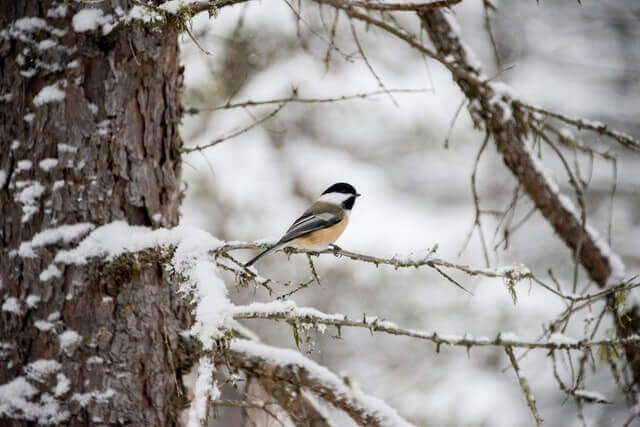
The black-capped chickadee is a small, black and white bird that inhabits the northern United States and Canada. They live in forested areas with dense undergrowth or near water sources such as lakes, ponds, and streams. Black-capped chickadees feed on insects they find on tree bark and leaves during the summer months when there are more of them available.
In winter, these birds will also eat seeds from various plants including cedar trees, evergreens, maple, fir, and spruce. They are non-migratory birds but will migrate south for winter if there is a lack of food or temperatures get too cold in their home range.
- Frequency: 49.48% (Statistic: eBird)
- Color: Black-cap, white on face, white/reddish-brown flanks
- Habitat: Deciduous and mixed forests, backyards, parks
- Range: USA and Canada
- Size: 11.5 -16 cm length
- Weight: 8 – 15 grams
- Diet: Insects, seeds, berries
- Family: Paridae
- Genus: Poecile
- Maps: Range Map – Sightings Map
- Sounds: Calls and Songs
Related: How Do I Attract Chickadees To My Yard?
American Crow
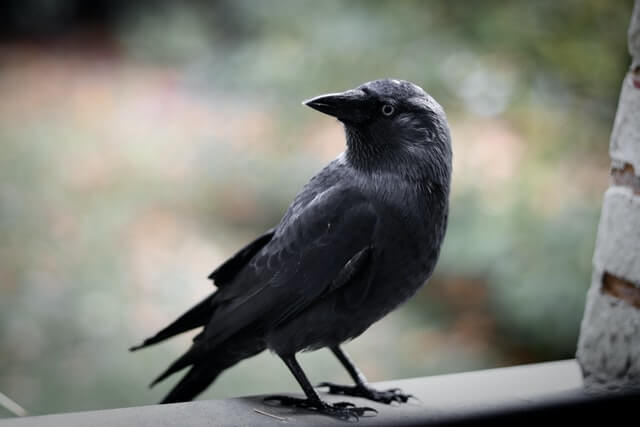
The American Crow is one of the most widespread and successful birds in North America. They are found on every continent except Antarctica and have been introduced to Australia. Their range extends from Alaska down to Mexico, with breeding populations as far south as Guatemala.
Their habitat includes forested areas, open fields, deserts, and even suburbs. The diet of the American Crow includes invertebrates such as earthworms or crickets, small vertebrates like frogs or mice that they capture alive before feeding them to their chicks.
- Frequency: 43.51%
- Color: Black
- Habitat: Open country, farms, parks, woodlands, towns, cities
- Range: Canada, USA, Mexico
- Size: 16 – 21″ inches
- Weight: 315 -620 grams
- Diet: invertebrates, carrion, seeds, eggs fish, grains, mice, frogs, and other small animals.
- Family: Corvidae
- Genus: Corvis
- Maps: Range Map – Sightings Map
- Sounds: Calls and Songs
Related:
American Robin
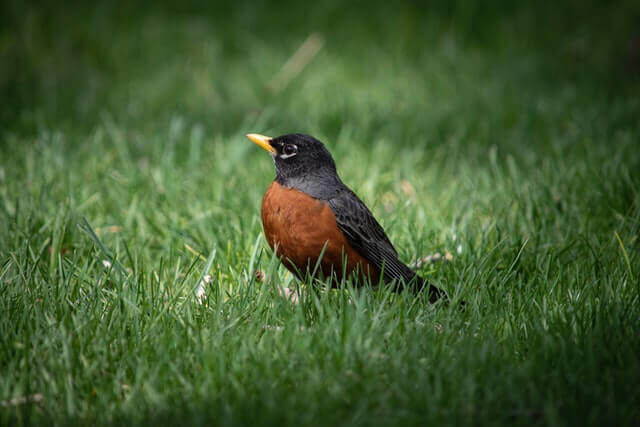
The American Robin is a migratory songbird that can be found across North America. They are best known for their distinctive red breast and yellow-orange bill. The robin’s range extends from Canada to Central America, south through the United States, and into northern South America. They live in forests, wetlands, gardens, or parks with dense undergrowth and trees near water sources.
They mostly eat insects, fruits and berries, but will also occasionally feed on small vertebrates. Robins migrate from cold regions during winter months, they migrate south to warmer climates like Florida or California and return in the spring.
- Frequency: 36.66%
- Color: Mostly brown on the back with an orange colored breast
- Habitat: Wooded areas, backyards, parks, fields
- Range: USA, Canada, Mexico
- Size: 12 – 16″ inches
- Weight: 72 – 95 grams
- Diet: Fruits, berries and insects (earthworms, beetles, caterpillars
- Family: Turdidae
- Genus: Turdus
- Maps: Range Map – Sightings Map
- Sounds: Calls and Songs
Related:
Blue Jay
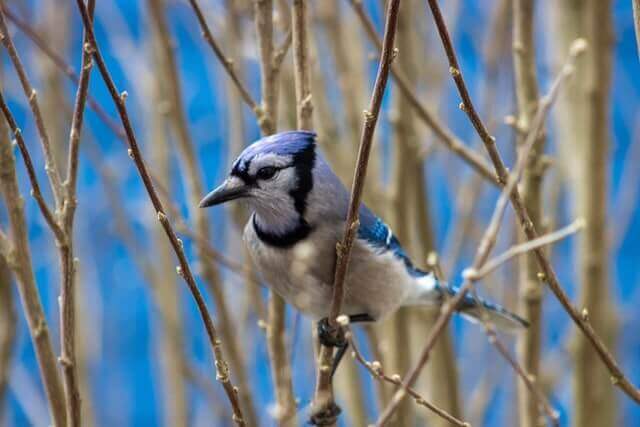
The Blue Jay is a common, medium-sized bird that can be found in the United States and Canada. The range of this species is from Newfoundland to Florida, and westward across most of the continental US. It has also been spotted as far north as Alaska.
They have an extensive range because they are nomadic creatures with migratory patterns that extend throughout North America during certain seasons. They inhabit open forests, brushy fields, suburbs, orchards, and rural gardens where they feed on mainly nuts and seeds but also insects such as beetles or ants when food is scarce.
- Frequency: 33.51%
- Color: Blue crest on the head, wings, back, and tail, and has a white face and belly
- Habitat: Deciduous and mixed forests, mixed woodlands, backyards, parks
- Range: Southern Canada, Eastern and Central United States, Florida and Texas
- Size: 8 – 12″ inches
- Weight: 70 – 100 grams
- Diet: Nuts, seeds, caterpillars, grasshoppers, and beetles
- Family: Corvidae
- Genus: Cyanocitta
- Maps: Range Map – Sightings Map
- Sounds: Calls and Songs
Related:
- How to Attract Blue Jays to your Yard?
- Do Blue Jays Migrate? The Truth
- What do Blue Jay Eat – All The Facts
- 15 Best Bird Feeders for Blue Jays
American Goldfinch
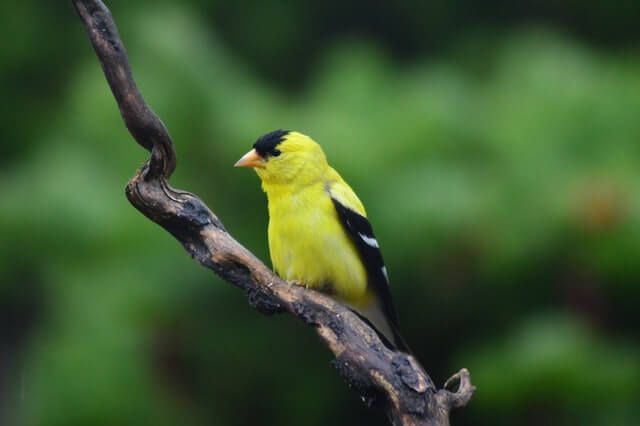
The American Goldfinches are a small, common bird that is found in many parts of North America. They live primarily in the Western United States and have been seen east of the Rocky Mountains, but sightings have become rarer. They feed on seeds, berries, nectar, and insects and can be found living near water sources or farmlands.
Their natural habitat is high-altitude woodlands with open spaces for foraging or nesting purposes. Some birds migrate to warmer climates for the winter while others stay where they live year-round.
- Frequency: 29.70%
- Color: Face, neck, and underside are yellow, black wings with white bars
- Habitat: Deciduous forests and thickets, roadside, grasslands, backyards, meadows
- Range: Canada, USA and Mexico
- Size: 4.3 – 5.5″ inches length
- Weight: 12 -18 grams
- Diet: Grass, dandelions, chickweed, sunflowers and ragweed, thistle, red alder, birch, spruce seeds
- Family: Carduelinae
- Genus: Spinus
- Maps: Range Map – Sightings Map
- Sounds: Calls and Songs
Related: American Goldfinch Interesting Facts
Downy Woodpecker
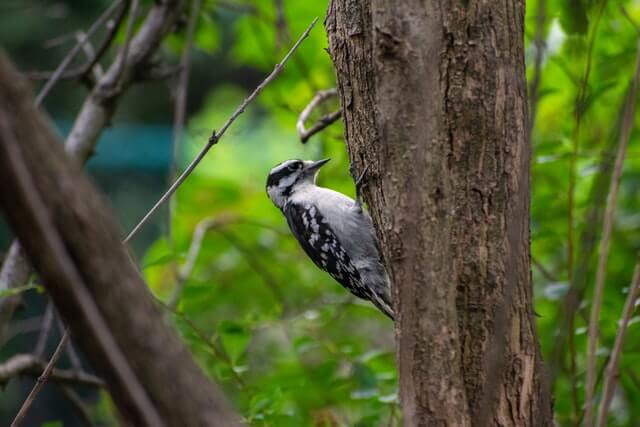
The Downy Woodpecker is a small bird that can be found throughout North America. The range of the Downy Woodpecker includes Alaska and Canada to south Texas and New Mexico in the United States. It has also been spotted in the Western and Eastern Hemispheres, as well as parts of Europe.
They prefer to live in deciduous forests, though they are not exclusively limited to these habitats. Their diet consists mostly of insects but includes nuts, seeds, and berries when available. The most notable part about this bird is its migration patterns which occur during the winter months for breeding purposes only.
- Frequency: 29.35%
- Color: Black with a white throat, belly, and back. White spots on wings
- Habitat: Deciduous forests and thickets, roadside, grasslands, backyards, parks
- Range: Canada, USA, and Mexico
- Size: 5.5 – 7.1″ inches in length
- Weight: 20 – 33 grams
- Diet: Mostly insects and beetles and ants, also gall wasps, caterpillars
- Family: Picadae
- Genus: Dryobates
- Maps: Range Map – Sightings Map
- Sounds: Calls and Songs
Related:
White-breasted Nuthatch
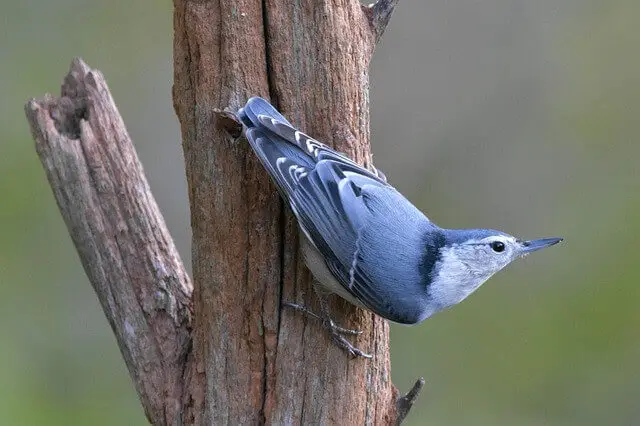
The white-breasted nuthatch is a common bird found throughout much of North America, particularly in the southern parts of Canada, northern areas of the United States, and central Mexico. It’s also a very active bird, particularly during the spring and summer, when it’s most common in areas of high bird population.
The male nuthatches are known for their aggressive behavior. They generally prefer mature, old wood, and will need the presence of mature oak trees for shelter. White-breasted nuthatches are also very popular visitors to backyard bird feeders.
- Frequency: 27.31%
- Color: Has a white face, flanks, and chest. It has a black cap on its head a bluish-gray upper and a brown belly
- Habitat: Deciduous forests, conifers, roadside, rivers, backyards, parks
- Range: Southern Canada, USA
- Size: 5.9″ inches
- Weight: 20 grams
- Diet: Acorn nuts, hickory nuts, ants, caterpillars, scale insects, pine weevils
- Family: Sittidae
- Genus: Sitta
- Maps: Range Map – Sightings Map
- Sounds: Calls and Songs
Related: How to Attract Nuthatches to your Backyard
Northern Cardinal
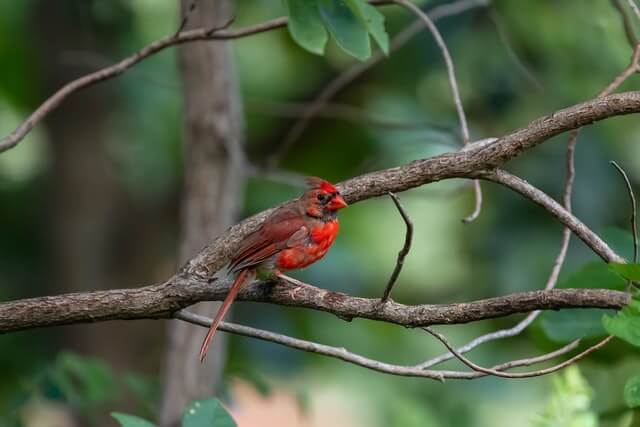
The Northern Cardinals are one of the most common birds in North America. The bird is mostly found in the Eastern United States but also migrates to California during the winter months.
Their habitat is forests, suburbs, and parks with trees or shrubs for nesting sites. The diet of a northern cardinal consists mainly of seeds, fruits, and insects. These birds typically live near human habitation due to a fondness for bird feeders and house gardens.
- Frequency: 26.97%
- Color: Mostly red with a black mask on the face, short pink bill
- Habitat: woodlands, gardens, parks, backyards, and wetlands
- Range: USA, Canada, Mexico
- Size: 8.2 – 9.3″ inches
- Weight: 33 – 65 grams
- Diet: Fruits, berries, and insects (grasshoppers, beetles, snails, cicadas)
- Family: Cardinalidae
- Genus: Cardinalis
- Maps: Range Map – Sightings Map
- Sounds: Calls and Songs
Related:
- Where are Cardinal Birds Found – Best Places to Look
- Cardinal Bird Facts You Never Knew
- 10 Best Bird Feeders for Cardinals
Red-winged Blackbird
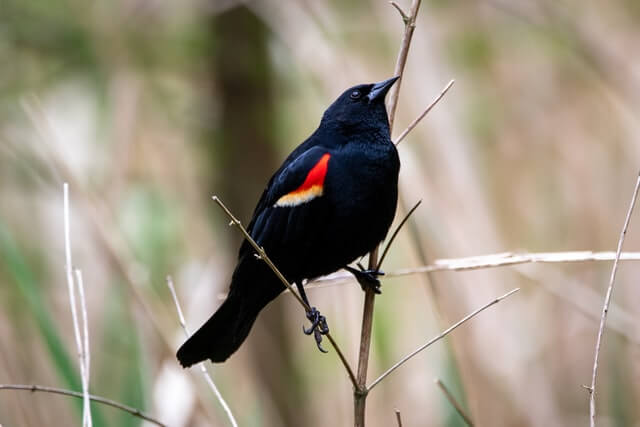
The Red-winged Blackbird is a North American bird species that live in marshes, lakes, and wet meadows. It has a broad range of habitats, from the Atlantic coast to the Rocky Mountains. They are typically found in large groups that occupy wetland habitats and have been known to breed in association with human development as well as agricultural fields such as rice plantations.
Their diet consists mainly of insects like flies, beetles, and other small invertebrates. The red-winged blackbird migrates south during winter months for the warmer climate found in Central America and the southern United States, returning north in the spring.
- Frequency: 26.26%
- Color: All black with red patches on shoulder and a yellow wing bar
- Habitat: Deciduous forests, conifers, roadside, rivers, backyards, parks
- Range: North America, Central America
- Size: 6.7 – 7.1″ inches length
- Weight: 41.5 – 65 grams
- Diet: Seeds and insects (butterflies, dragonflies, moths, frogs, worms, spider, snails, carrion, flies.)
- Family: Icteridae
- Genus: Agelaius
- Maps: Range Map – Sightings Map
- Sounds: Calls and Songs
Song Sparrow
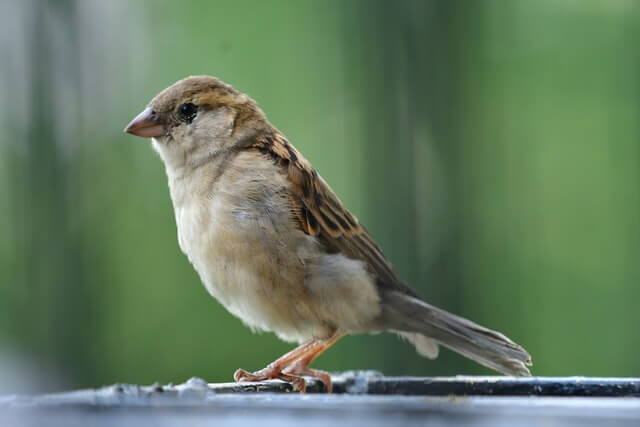
The Song Sparrow is a small songbird native to North America. They have been found in every state in the continental United States and most Canadian provinces, as well as Central America and parts of northern South America. The Song Sparrows range includes open fields, meadows, weedy lots, grasslands, marshes and wetlands.
Its diet consists mainly of insects, but also include seeds from weed-seeds or corn; they sometimes eat small snails or worms. In the winter, they migrate southward towards Mexico or Central America.
- Frequency: 23.68%
- Color: Gray head, white cheek, a black bib, rufous neck
- Habitat: Urban centers, farms, backyards, edges, yards, and parks
- Range: Europe, Mediterranean, Asia, Australasia, Africa, and the Americas
- Size: 5.5 – 7.0″ inches
- Weight: 25 – 40 grams
- Diet: Grains, seeds, and insects
- Family: Passeridea
- Genus: Passer
- Maps: Range Map – Sightings Map
- Sounds: Calls and Songs
Related: How to Attract Sparrows to your Backyard
Hairy Woodpecker

The Hairy Woodpecker is a medium-sized woodpecker. The bird’s range covers the northern United States, and it can be found in every Canadian province except for Newfoundland. The bird also lives in Mexico, most of Central America, South America north of Argentina and Chile (except for Colombia), Ecuador, Peru, Bolivia and Brazil.
They have mostly been seen inhabiting forests, especially pine or mixed deciduous-coniferous forests, but will sometimes venture into open fields. The diet of this bird mainly consists of insects such as ants, beetles, caterpillars, grasshoppers and other bugs. This bird also feeds on nuts from trees like hickory and walnut.
- Frequency: 18.28%
- Color: Black and white checkered throughout, all white underside, has a mask
- Habitat: Wooded areas, forest edges, roadsides, gardens, parks.
- Range: USA and Canada
- Size: 7.0 – 10″ inches in length
- Weight: 40 – 95 grams
- Diet: Berries, seeds, nuts beetles, ants, caterpillars, and others.
- Family: Tyrannidae
- Genus: Tyrannus
- Maps: Range Map – Sightings Map
- Sounds: Calls and Songs
Red-bellied Woodpecker
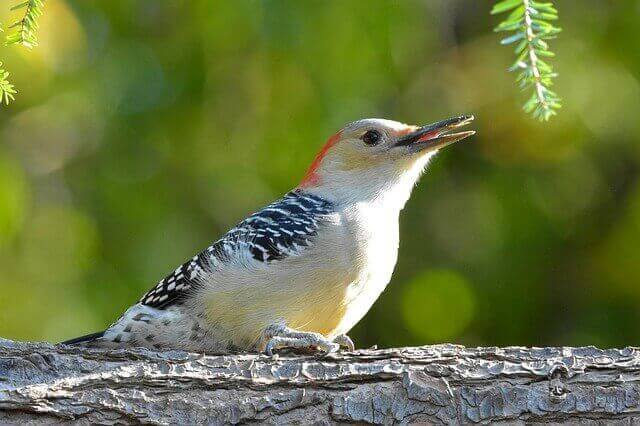
The Red-bellied Woodpecker is a medium-sized woodpecker that resides in North America. The Red-bellied Woodpecker’s range includes Canada, Mexico and the United States except for New England. They are found year round throughout most of their range, but they migrate to Florida and Central America during winter months. Red-bellied woodpeckers live in deciduous forests with an abundance of dead trees, snags, and standing dead trees that have not yet fallen over.
The range includes many types of habitats, including both forested wetlands and upland hardwood forests, open woodlands dominated by oak or hickory. The birds prefer to eat insects like ants, beetles and larvae which they get by drilling into the tree trunk or branches of trees.
- Frequency: 17.62%
- Color: Gray on body and face and underparts. Black and white pattern on wings, back, and tail.
- Habitat: Forests, backyards
- Range: Southern Canada, Eastern United States, Florida
- Size: 9 – 10.6″ inches long
- Weight: 56 -91 grams
- Diet: Insects, tree frogs, eggs of small birds, oozing sap, and small fish.
- Family: Picidae
- Genus: Melanerpes
- Maps: Range Map – Sightings Map
- Sounds: Calls and Songs
Related: How to Attract Red-bellied Woodpeckers to your Yard?
Mourning Dove
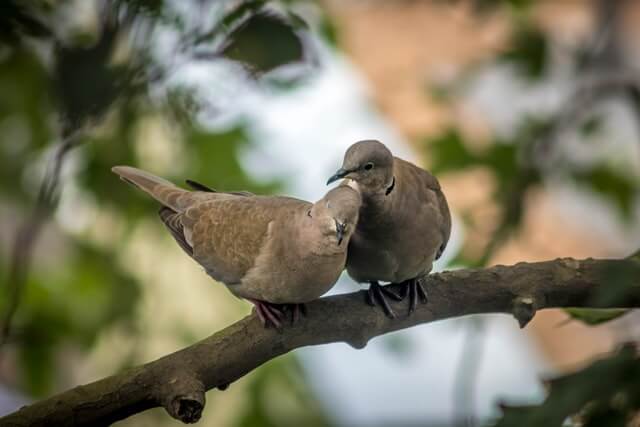
The Mourning Dove is a bird that belongs to the Columbidae family. They are found in North America, South America and some parts of Europe. These birds are mostly known for their gentle cooing noise and nesting habits. Their range extends from central Canada down to Mexico. Their habitat ranges from deserts to high mountain forests, but they tend to prefer open woodlands, or savannahs with scattered trees or shrubs as well as agricultural areas near water sources such as ponds, rivers, and lakes.
Their diet consists mainly of seeds and grains, but they will also eat insects, small mammals, eggs and young birds when available. They are nomadic birds who will migrate if they feel threatened by cold weather or other environmental factors like drought or food shortages.
- Frequency: 17.41%
- Color: Light gray-brown and lighter and pinkish below. The wings have black spots.
- Habitat: Open habitats, urban areas, farms, prairie, grassland, wooded area
- Range: USA, Canada, Mexico, Central America, Greater Antilles
- Size: 12″ inches length
- Weight: 112 – 170 grams
- Diet: Rapeseed, corn, millet, safflower, sunflower seeds, pokeberry, sesame, and wheat.
- Family: Columbidae
- Genus: Zenaida
- Maps: Range Map – Sightings Map
- Sounds: Calls and Songs
Related: Facts About Mourning Doves – 10 Things You Need To Know!
Dark-eyed Junco
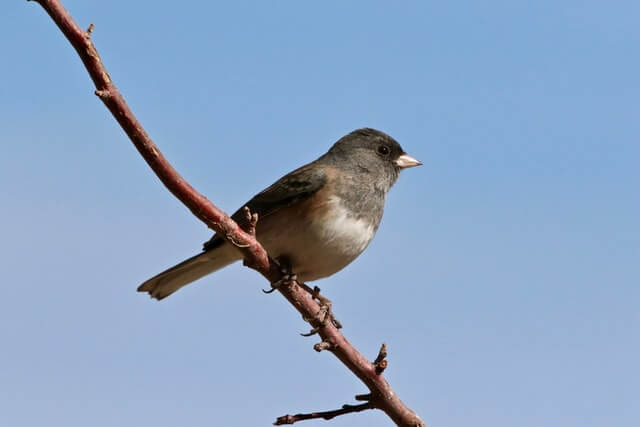
The Dark-eyed Junco is a bird that has the widest range of any species in North America. They live all over Canada and most of the United States, excluding only some deserts and high mountains. They can be found from coast to coast, north to south.
They can be found in coniferous forests, shrubby areas, as well as city parks and suburban yards. This species’ diet consists of various seeds, berries and invertebrates. Their winter migration pattern takes them southward from the northern U.S., across Central America to Argentina, where they spend the warmer months feeding on insects.
- Frequency: 15.45%
- Color: Gray head, neck, breast, gray/brown backs and wings, white underside
- Habitat: Wooded areas, forest edges, roadsides, gardens, parks.
- Range: USA and Canada
- Size: 5.1 – 6.9″ inches
- Weight: 18 – 30 grams
- Diet: Seeds, insects, and arthropods
- Family: Passeriformes
- Genus: Junco
- Maps: Range Map – Sightings Map
- Sounds: Calls and Songs
Related: Fun Facts About Dark-eyed Juncos
Common Grackle
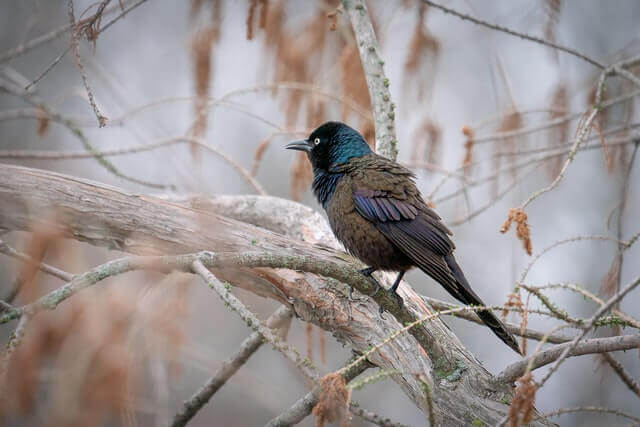
The Common Grackle is a bird found in the eastern United States. They can be seen year-round, but they are most common during the summer months. Grackles have been recorded as far north as Alaska and southern Canada, and as far south as Panama and Brazil.
The grackle population has grown to include almost every country with an east coast or ocean coastline that’s west of India. The habitats range from wetlands to suburban yards, golf courses, farms, pastures and lakeside. This bird will forage on land or in water, eating seeds, insects, worms and other small invertebrates.
- Frequency: 15.21%
- Color: Black overall with a blue, and purple iridescence. Its body plumage is a shimmering copper color.
- Habitat: Woodlands, marshes, meadows, parks, backyards, and fields
- Range: East of the Canadian Rockies, Canada and the United States
- Size: 11 – 13″ inches length
- Weight: 75 – 143 grams
- Diet: minnows, eggs, berries, seeds, grain, insects, frogs, mice
- Family: Icteridae
- Genus: Quiscalus
- Maps: Range Map – Sightings Map
- Sounds: Calls and Songs
House Sparrow
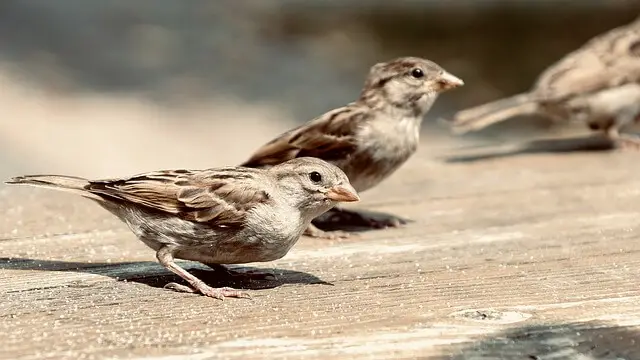
The House Sparrow is a small bird that breeds in North America, Europe and Asia. The range of the House Sparrow covers most of the United States and Canada. They are also found in Mexico, Costa Rica, El Salvador, Guatemala, Honduras and Nicaragua. In South America, they can be found as far south as Peru, but not Chile or Argentina. Their habitat includes cities, towns, farmland, meadows with grassy fields for nesting sites to urban areas with gardens containing ornamental plants.
They primarily feed on seeds, grains, fruits and insects but will also take eggs or nestlings from nests of other birds such as swallows or robins. House sparrows will often migrate with their breeding partners if they don’t migrate together as a family unit, and it’s not uncommon for them to return home year after year to raise their young.
- Frequency: 15.14%
- Color: Gray head marking, a reddish-brown back, and gray underparts
- Habitat: Urban centers, suburban areas, backyards, edges, yards, and parks
- Range: North America, Central America, South America, Africa, Australia, New Zealand
- Size: 5.5 – 7.1″ inches in length
- Weight: 25 – 39 grams
- Diet: Insects, beetles, caterpillars, aphids,, grasshoppers, crustaceans, earthworms, vertebrates
- Family: Passeridea
- Genus: Passer
- Maps: Range Map – Sightings Map
- Sounds: Calls and Songs
Related: How to Attract Sparrows to your Backyard
Chipping Sparrow
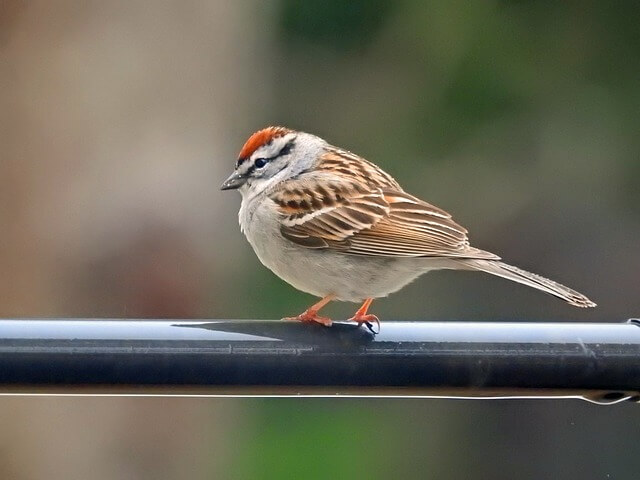
The Chipping Sparrow is a common songbird in North America. The Chipping Sparrow’s range covers much of the United States and Canada, with their habitat ranging from farmland to urban areas. They live mostly in scrubby vegetation, open fields, grasslands and pastures.
The diet of this bird consists mainly of insects and other invertebrates which they glean from leaves or bark on trees, bushes, and low vegetation; some will eat seeds or fruit as well. These birds migrate south for the winter, heading as far south as Central America or northern South America, depending on where they live in the summer months.
- Frequency: 23.92%
- Color: Rust-colored upper parts, gray head, and underparts with a reddish cap on the head
- Habitat: Coniferous forests, woodland, farmland, parks, and gardens
- Range: Southern USA and Mexico
- Size: 4.7 – 5.9″ inches
- Weight: 11 – 16 grams
- Diet: Mostly seeds, spiders, some fruit.
- Family: Passerellidae
- Genus: Spizella
- Maps: Range Map – Sightings Map
- Sounds: Calls and Songs
Related: How to Attract Sparrows to your Backyard
European Starling

European starlings are one of the most common birds in North America. These songbirds range from Eastern Europe to Siberia and Asia, though they can be found across all of Europe and into Africa. European starlings typically inhabit areas near open water or moist land. Their diet includes insects, spiders, worms, small mammals, fruit and berries; however it also includes carrion as well as garbage when available.
This migratory bird flies south for the winter to warmer climates where it does not have to endure cold winters like those in its native range. One of their most distinguishing features is their ability to migrate long distances by night without rest.
- Frequency: 13.32%
- Color: Black with glossy iridescence plumage
- Habitat: Forests, woodlands, backyards, edges, yards, and parks
- Range: North America, Europe, Africa, India, Middle East, China
- Size: 7 – 9″ inches long
- Weight: 60 – 100 grams
- Diet: Insects (ants, beetles, invertebrates), fruits, seeds, berries
- Family: Sturnidae
- Genus: Sturnus
- Maps: Range Map – Sightings Map
- Sounds: Calls and Songs
Related: How to Attract European Starlings to your yard?
House Finch
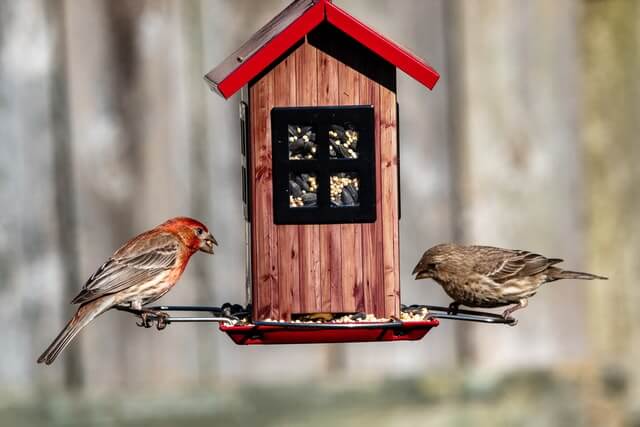
House finches are a type of small bird native to North America. They live in many habitats, but typically reside in the eastern part of the United States and Canada. They eat mostly seeds, grains, berries and nuts as well as insects like grasshoppers and caterpillars.
They live in open habitats such as open areas, forests, grasslands, farmlands, fields, meadows, parks and gardens. House finches migrate during the winter months, flying south into Mexico or Central America for breeding season before returning north to Canada and the United States for spring migration.
- Frequency: 12.89%
- Color: Reddish face and upper breast, brown streaks on back, belly, and tail.
- Habitat: urban and suburban areas, backyards, edges, yards, and parks
- Range: Canada, USA, Mexico
- Size: 5 – 6″ inches
- Weight: 16 – 27 grams
- Diet: Aphids, grains, seeds, berries, nettle, dandelion, sunflower
- Family: Fringillidae
- Genus: Haemorhous
- Maps: Range Map – Sightings Map
- Sounds: Calls and Songs
Related: How to Attract House Finch to your yard?
The backyard birds below have a frequency of less than 12%.
- Tree Swallow (11.57% Frequency)
- Rock Pigeon – 11.48%
- Gray Catbird – 11.46%
- Northern Flicker – 10.96
- Barn Swallow – 10.71%
- Common Yellow-throat – 10.56%
- Yellow-rumped Warbler – 10.52%
- White-throated Sparrow – 10.44%
- Brown-headed Cowbird – 9.95%
- House Wren – 9.94%
- Cedar Waxwing – 9.16%
- Pileated Woodpecker – 9.07%
- Killdeer – 8.47%
- Yellow Warbler – 8.42%
- Red-breasted Nuthatch – 8.30%
Frequently Asked Questions
What is the biggest bird in MN?
The Sandhill Crane is the largest bird in Minnesota. The adults can grow up to 4 feet tall and have a wingspan of 6-7 feet, while weighing around 10 pounds.
What’s the most common bird in Minnesota?
The black-capped chickadee is the most frequently seen bird in Minnesota. This bird has a frequency of occurrence of 49.5% in 2022, which means that they are present at least once out of every two sightings.
What is the rarest bird in Minnesota?
There are many rare birds in Minnesota, and some of the most rare include the black-throated sparrow, Groove-billed Ani, Magnificent Frigatebird, White Ibis, White-tailed Kite, Monk Parakeet and McCown’s Longspur. These birds have a frequency of occurrence of 0.0001%.
What birds stay for the winter in Minnesota?
There are many birds that stay for the winter in Minnesota. The 13 most common ones are the Dark-eyed junco, Northern Cardinal, European Starling, White-breasted Nuthatch, Red-breasted Nuthatch, House Sparrow, Woodpeckers, Blue Jay, American Goldfinch, Black-capped Chickadee, American Crow, House Finch, and American Robin.
What are the yellow birds in Minnesota?
There are two main types of yellow birds that live in Minnesota: the American Goldfinch and the Yellow Warbler. The American Goldfinch is the most common type of yellow bird, and then there are less-common varieties like the Yellow Warbler, and Yellow-breasted Chat.
How many species of birds live in Minnesota?
A bird watcher’s paradise, Minnesota has 448 species of birds. Some may be rare and hard to find, while others are common across the state. Some are found year-round, while others migrate for winter or summer and return later on. Minnesota is a hotspot for birdwatchers and other nature enthusiasts alike because it houses so many species.
What is the smallest owl in Minnesota?
The saw-whet owl is the smallest owl in Minnesota. It weighs about 2-5 ounces and is only 7-8 inches tall, and has a wingspan of around 16-19 inches.
Do chickadees stay in Minnesota for the winter?
Chickadees are one of the few bird species that stay in Minnesota for the winter. While most birds migrate south for the colder months, chickadees are content to stay put. These little birds are well-adapted to survive the cold weather. They have a thick layer of feathers that keep them warm, and they can also fluff up their feathers to trap even more heat.
Are house finches common in Minnesota?
Yes, house finches are common in Minnesota. According to the Cornell Lab of Ornithology, they have a frequency of occurrence of over 14 percent in Minnesota. That means that out of every 100 birds seen in Minnesota, at least 14 of them will be house finches.
Related Post: 22 Backyard Winter Birds in Minnesota 2022 (Photos, Info)



